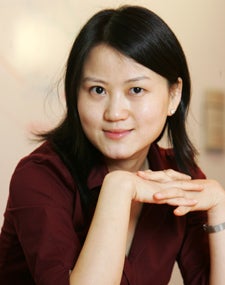A Digital Landscape of Diseases
USC Dornsife scientists and their colleagues have been awarded a $5.5 million grant from the National Institutes of Health (NIH) to study disease connections as part of a collective of research centers.
Jasmine Zhou, associate professor of biological sciences and computer science, and Edward Crandall, professor of medicine in the Keck School of Medicine of USC, are co-principal investigators of the five-year grant, funded by the NIH’s National Heart, Lung and Blood Institute.
The USC team will establish a coordination center for the consortium of Cross-Organ Mechanism-Associated Phenotypes for Genetic Analysis (MAPGen), a newly founded collective of research centers that aim to redefine heart, lung, blood and sleep disorders based on their molecular mechanisms at the genetic level.
Each of the consortium’s research centers will focus on examining the mechanisms of individual diseases and relay their findings to the coordination center, called the MAPGen Knowledge Database (MAPGenKB), which will be based at USC.
“Our role is to coordinate activities and integrate the findings of MAPGen to discover the connections among diseases in different organ systems,” Zhou said. “Once we determine the signature molecular operations of each disease, we can then establish a network of diseases based on their shared molecular mechanisms.”

Jasmine Zhou, associate professor of biological sciences and computer science in USC Dornsife, is a principal investigator of a grant from the National Institutes of Health to study disease connections. Photo by Phil Channing.
The resulting digital collection of information from MAPGenKB will be the world’s most comprehensive database documenting the shared molecular base of diseases.
New genomic technologies have generated an enormous quantity of genetic information about diseases and their relationships, so the USC researchers must wade through this data to find specific connections.
“Patterns in biology are approximate in space and not precise, so getting a signal out of the biological noise is a key problem,” said co-investigator Michael Waterman, University Professor, USC Associates Chair in Natural Sciences and professor of biological sciences, computer science and mathematics in USC Dornsife.
“Advanced statistical and computational tools are needed to tease out the intricate connections between gene networks and diseases based on the knowledge,” said co-investigator Fengzhu Sun, professor of biological sciences in USC Dornsife. “The computational biology group at USC has led the efforts in developing such tools for the past several years.”
Understanding and diagnosing diseases on the molecular level is a relatively recent approach. Zhou explained that for centuries, diseases have been defined by their clinical symptoms and by the organ system in which they manifest, such as a lung disease or heart disease. More recently, however, there is evidence that diseases with the same symptoms could have different molecular mechanisms, or likewise, diseases with different symptoms in different organ systems could be caused by the same molecular mechanism.
“For example, insulin resistance can cause diabetes, but it can also cause sleep apnea,” Zhou said. “They look very different, but share the same mechanisms.” The MAPGenKB group at USC will be responsible for identifying such connections.
The team will collect information from the MAPGen consortium as well as public databases of genetic data. The more data they have about diseases, Zhou said, the more questions they can ask about the connections among them.
The group will also strive to redefine and regroup diseases based on their molecular mechanisms, and provide strategies for repurposing existing drugs for new treatments.
“Based on the molecular similarities among diseases, we could predict what sort of drug could be used to treat other diseases,” Zhou said. As the drug discovery process is long and costly, this type of shortcut could save time, money and lives.
Ultimately, the MAPGenKB group hopes to release a public database that scientists and physicians alike could utilize as part of their research and diagnostic process, helping them identify biomarkers that could predict more than one disease, anticipate disease progress and prescribe the best medications for individual patients.
“We have entered the age of molecular medicine, in which understanding of mechanisms underlying diseases takes on a more important role in translational/clinical research,” Crandall said. “One of the goals of this work will be to enhance opportunities for personalized treatment strategies based on knowledge of genetic and epigenetic mechanisms involved in each patient’s disease.”
Zhou and Crandall will collaborate with co-investigators Waterman; Sun; Preet Chaudhary, professor of medicine in the USC Norris Comprehensive Cancer Center; and Andrey Rzhetsky of The University of Chicago.